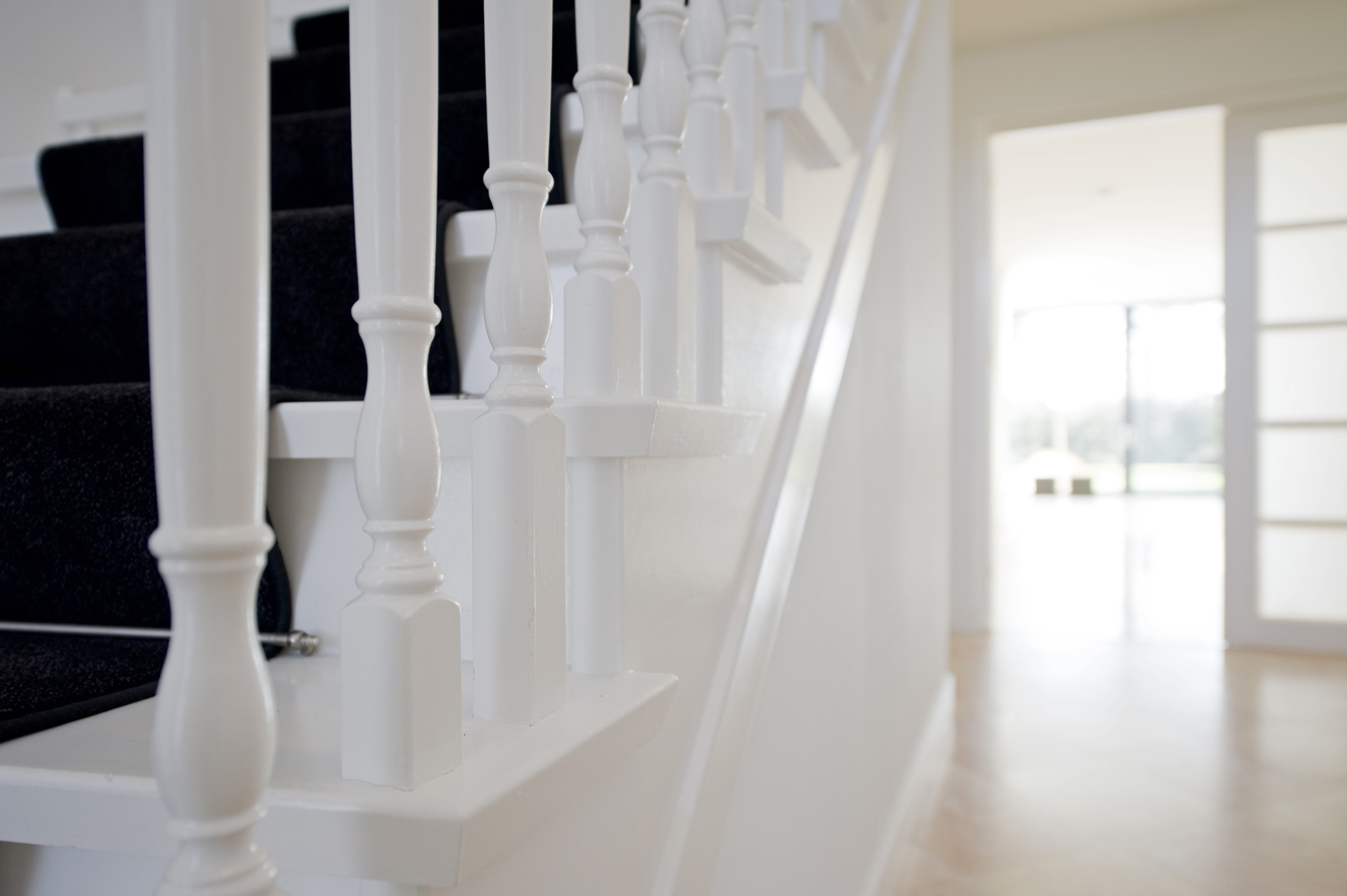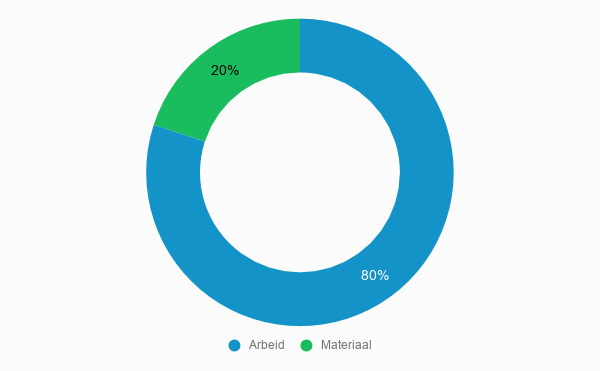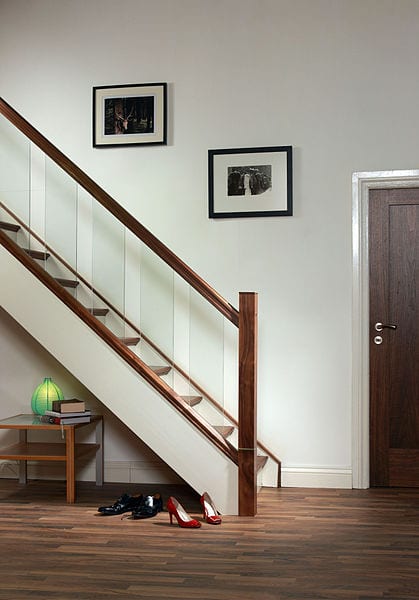Is your staircase due for a refurbishment and are you curious about what it will cost? Renoca offers you a comprehensive overview with all prices and options to create the perfect staircase. Below you can read more about painting costs and all the options for your home.
What does it cost to paint a staircase?
To have a staircase painted by a painting company costs an average of £45 per hour, including paint. The cost of painting a staircase averages £600. Of course, the cost can be higher or lower, depending on, for example, the type of staircase you have painted. See below for the average costs of staircase painting.
| Painting price per hour incl. paint, materials and VAT | Average cost ( from 1 to 3 layers of paint) |
|---|---|
| £ 40 – £ 50 | £ 500 – £ 800 |
Find the best specialist for your project and get free quotes.
Start

Price examples
The price table above shows you an overview of the average prices for having your staircase painted. To be more specific and give you an idea of the costs in some common situations, here are three price examples.
Small painting
Was your staircase already painted and is still in great condition, but in need of a fresh coat of paint? Having a staircase painted costs an average of £600 including paint and materials.
Average painting
Would you like to have the stairs to the first floor taken care of as well as those to the attic? The cost of having two staircases painted starts at £1,000.
Great painting
Do you have a staircase that needs a bit more attention? For example, because you want to move from stair covering to painting your stairs, or because there are cracks in the steps of the stairs. If you have one staircase stripped, sanded, cleaned and painted with three layers, you will spend an average of £800.
Price structure of a staircase painting

How to paint a staircase?
How does painting a staircase actually work? We’ve listed the steps. So you know how a painter will work or you can get started yourself.
1. Cover the surrounding floor and walls
First of all, it is important to cover the floors at the top and bottom of the stairs. Are your stairs directly adjacent to one or more walls? These are also covered. This is because a lot of dust is released during sanding.
2. Remove any carpet
The next step depends on the current situation of your staircase. Is there currently carpet on the stairs? Then the carpet will have to be removed first, as well as any glue residue. This is often done by thoroughly wetting the carpet with soapy water, repeating this again after a few hours and then pulling the carpet off.
3. Degreasing
Is the carpet completely off the stairs, or was there no carpet on the stairs in the first place? Then it’s time to properly degrease the stairs. After all, you don’t want any grease to be sanded into the stairs later. After this, let the stairs dry thoroughly.
4. Sanding
Is the staircase completely dry? Then sand it. This can be done with hand sandpaper, but painters often use a sanding machine with dust extraction. This prevents a lot of dust from being released when sanding.
Any loose paint leaves should also be removed from the stairs so that a nice end result can be achieved. Sanding the stairs well is important as it will allow the new paint to adhere better to the stairs. After sanding, make the stairs completely dust-free again.
5. Filling and sealing
Is the staircase dust-free? Then fill any unevenness and damage with a suitable putty knife. Gaps and seams can be filled with acrylic sealant. After all uneven areas have been removed, it is important to sand those areas again and then make the staircase completely dust-free.
7. Primer
Check that the staircase is well taped. Then it is time for a coat of primer. The primer should dry well before sanding the staircase lightly. Of course, the stairs should be cleaned well again.
8. Paint the stairs
Use special stair paint for your stairs. Water-based acrylic paint does not smell and is better for the environment than alkyd paint. A good staircase paint is wear- and scratch-resistant, so your stairs will last for years. With acrylic paint, make sure you use brushes and/or rollers that are suitable for this purpose – a painter will know which ones are best suited.
The painter will paint the steps of the stairs alternately. This is because the paint needs quite a few hours to dry and this way the stairs can continue to be used. Because of the drying time, painting the stairs – depending on your requirements – can take several days. The stairs get two coats of paint due to wear and tear from frequent use. Most stair lacquers are repaintable after 5 to 6 hours.
To ensure that you can enjoy the staircase for as long as possible, it is important to let the paint on the stairs dry out properly. A period of at least seven days is advised for this. In the meantime, only go up the stairs with socks, but not shoes.
What affects the price of painting my stairs?
The total price of painting your stairs depends mainly on the painter you hire and how much needs to be done to get your stairs back in tiptop condition. In addition, there are additional options that can make the price of having your stairs painted go up or down. Read more about them below.
Influence 1: Type of staircase
First of all, the type of staircase you want to have painted determines the price. An open staircase needs to be painted on both the top and bottom. A staircase with closed treads does not, so the costs for these stairs will be lower.
The condition of the stairs also determines the price. Are your stairs still in good condition? Then less repair work will need to be carried out, leading to a lower total price. Was there stair covering on the stairs and does it need to be removed? This is an extra step, which means the painter will be working longer. As a result, labour costs will be higher.
Influence 2: Painter
If you have your staircase painted, the painting costs often consist of a total price based on an hourly price for because it involves detailed painting: a staircase has many nooks and crannies that need to be painted accurately. The hourly price varies from £40 to £50. A big advantage of a professional painter is that he works quickly and accurately, which means that before you know it, you will be walking over a freshly painted staircase again.

Incentive 3: Paint
As indicated above, it is wise to use a good staircase paint for painting your staircase. Good water-based acrylic paints are resistant to wear and tear from frequent use and are also scratch-resistant. Stair lacquer is also non-slip, so you will soon be able to walk up the stairs in socks without any worries.
The overview below shows the recommended paints for painting stairs, how much they cost and how much you will need to paint your stairs. Will you leave the project to a painter? If you have very specific requirements for the paint for your stairs, you can choose to pick the paint yourself instead of letting the painter determine it. But always consult the painter first to make sure the painter can use the paint.
| Paint type | Price per litre incl. vat | Number of m2 per litre | Exceptions |
|---|---|---|---|
| Ground paint | £ 20 – £ 70 | 8 – 12 | Undercoating |
| Covering stair paint / varnish | £25 – £75 | 8 – 16 | Treading paint |
Influence 4: Additional options
There are many options for making a staircase completely your own that affect the overall cost. For example, consider painting in various colours, or applying a pattern or painting to the stairs. You can also have stair mats or anti-slip strips fitted.
| Options | Price incl. VAT, excl. installation | Explanation |
|---|---|---|
| Anti-slip strips | £ 3 – £ 15 per metre | Anti-slip on stairs |
| Stair mats | £ 3 – £ 15 per mat | As an accessory, against slipping on the stairs |
| Lighting | £ 10 – £ 40 per spotlight or LED strip | Modern accessories for the stairs |
Kwantum discount
If you combine various painting jobs together, you will end up cheaper than if you have the projects picked up one by one. Do you doubt whether you also want to have your living room or kitchen painted, for example, or perhaps have the ceiling plastered? Ask the painter for a quote that includes these extra surfaces at an attractive total price. Below is an overview of average prices for the most painted surfaces in the house.
| Surface | Average costs incl. VAT | Details |
|---|---|---|
| Dormer window painting | £400 – £1,500 | From only side panel and side beam to full dormer window |
| Front window painting | £500 – £1,800 | From 7 m2 excl. paint to all exterior window frames of 1 house |
| Doors painting | £ 300 – £ 2,000 | 2 to 20 doors incl. door frames |
| Ceiling painting | £ 500 – £ 1.500 | From 30 m2 to 100 m2 |
Find the best specialist for your project and get free quotes.
Start